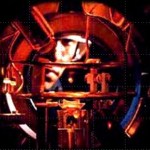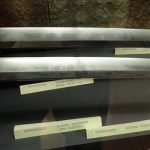
In our last installment of the cold-atom toolbox series, we talked about why you need magnetic traps to get to really ultra-cold samples-- because the light scattering involved in laser cooling limits you to a temperature that's too high for making Bose-Einstein condensation (BEC). This time out, we'll talk about how you actually get to those ultra-cold temperatures.
What do you mean? I assumed it was just part of the trapping process? No, because the forces involved in magnetic trapping are like those involved in optical dipole traps. In physics jargon, they're "conservative" forces, which…
A lot has been written about Steven Pinker's article about "scientism," most of it mocking his grandiose overreach in passages like this:
These thinkers—Descartes, Spinoza, Hobbes, Locke, Hume, Rousseau, Leibniz, Kant, Smith—are all the more remarkable for having crafted their ideas in the absence of formal theory and empirical data. The mathematical theories of information, computation, and games had yet to be invented. The words “neuron,” “hormone,” and “gene” meant nothing to them. When reading these thinkers, I often long to travel back in time and offer them some bit of twenty-first-…
We're getting toward the end of the cold-atom technologies in my original list, but that doesn't mean we're scraping the bottom of the barrel. On the contrary, the remaining tools are among the most important for producing and studying truly ultra-cold atoms.
Wait, isn't what we've been talking about cold enough? There is, as always, more art than science in the naming of categories of things. "Cold" and "ultra-cold" get thrown around a lot in this business, and the dividing line isn't quite clear. Very roughly speaking, most people these days seem to use "cold" for the microkelving scale…
Today's dip into the cold-atom toolbox is to explain the real workhorse of cold-atom physics, the magneto-optical trap. This is the technology that really makes laser cooling useful, by letting you collect massive numbers of atoms at very low temperatures and moderate density.
Wait a minute, I thought we already had that, with optical molasses? Doesn't that make atoms really cold and stick them in space? Molasses does half the job, making the atoms really cold, but it doesn't actually confine them. The photon scattering that gives you the cooling force and Doppler cooling limit produces a "…
Via a retweeted link from Thony C. on Twitter, I ran across a blog post declaring science a "bourgeois pastime." The argument, attributed to a book by Dierdre McCloskey is that rather than being at the root of economic progress, scientific advances are a by-product of economic advances. As society got more wealthy, it was able to direct more resources to science, which made great advances possible.
And, you know, if you're looking to make a bold and contrarian argument, you can certainly do that. Unfortunately, the bit quoted from McCloskey as an illustration of the power of the argument is:…
There was some buzz Thursday about a poll showing that 40% of white people don't have any friends of a different race. Ipsos/Reuters include a spiffy "data explorer" where you can make graphs like the one above. It does not appear to provide an easy way to get at the actual wording of the question, which is kind of crucial, and thus renders most of the stories about it too vague to take all that seriously.
Of course, this is somewhat reminiscent of the gender bias story from a couple of weeks ago, where it was shown that single-gender physics departments are not a clear indication of sexism.…
This topic is an addition to the original list in the introductory post for the series, because I had thought I could deal with it in one of the other entries. Really, though, it deserves its own installment because of its important role in the history of laser cooling. Laser cooling would not be as important as it is now were it not for the fact that cooling below the "Doppler limit" in optical molasses is not only possible, but easy to arrange. That's thanks to the "Sisyphus cooling" mechanism, the explanation of which was the main reason Claude Cohen-Tannoudji got his share of the 1997…
Long-time readers will remember that I used to do weekly kid-blogging, posting pictures of SteelyKid with a reference animal, Appa the sky-bison from the Avatar cartoon. I stopped a couple of years ago, because SteelyKid started being reluctant to pose for the pictures every week.
I got her to pose for a few yesterday, though, so we can see what a difference 260 weeks makes. Here's the first really good Appa-for-scale picture, one week after she was born:
SteelyKid and Appa at age one week, back in 2008.
And here they are on her fifth birthday (also the "featured image" for this post…
I spent an hour or so on Skype with a former student on Tuesday, talking about how physics is done in the CMS collaboration at the Large Hadron Collider. It's always fascinating to get a look at a completely different way of doing science-- as I said when I explained my questions, the longest author list in my publication history doesn't break double digits. (I thought there was a conference proceedings with my name on it that got up to 11 authors, but the longest list ADS shows is only eight). It was a really interesting conversation, as was my other Skype interview with a CMS physicist.…
SteelyKid was born five years ago today. I'd try to be clever and schedule this for exactly five years to the minute of her time of birth, but I've mercifully forgotten exactly when the delivery was, only that it was early in the morning after a very, very long night. Here's what she looked like then:
SteelyKid, five years ago today.
Here's what she looks like now, with her little brother for scale (also the "featured image" for this post):
SteelyKid and The Pip.
Or, if you prefer something a little more active, here she is engaged in the study of optics.
SteelyKid investigating…
Last time in our trip through the cold-atom toolbox, we talked about light shifts, where the interaction with a laser changes the internal energy states of an atom in a way that can produce forces on those atoms. This allows the creation of "dipole traps" where cold atoms are held in the focus of a laser beam, but that's only the simplest thing you can use light shifts for. One of the essential tools of modern atomic physics is the "optical lattice," which uses patterns of light to make patterns of atoms.
OK, what do you mean "patterns of light"? Well, remember, light has both wave and…
One of my colleagues at Union is doing a physics education research project with a summer student, and is using an online survey to collect data. Obviously, the more people respond to the survey, the more scientific it becomes (subject to the limitations imposed by relying on self-selected Internet samples, of course), so I offered to plug it here. Here's the blurb and link:
I'm doing a summer research project at Union College with a student, and I need as many people as possible to fill out a survey that we created. If you complete the survey by 11:59pm (EST) on Sunday, August 11, 2013, you…
SteelyPalooza came off very well, despite high disaster potential. We were, after all, inviting a dozen five-year-olds plus assorted siblings to our house, on a day when Kate and The Pip were out of commission due to coxsackie virus. Everything went smoothly, though: the kids loved the bouncy-bounce, SteelyKid's playset and playhouse, and the six-person tent we set up out back. They're getting close to an age where they can entertain themselves, so I was even able to enjoy snatches of adult conversation during brief lulls in my hosting duties.
This was, however, thoroughly exhausting, so…
SteelyKid turns five next Wednesday (F/X: "FIVE! YEARS!" like an incredulous Jeremy Piven in Grosse Point Blank), but we're having her party today. This is a distinction we've worked hard to get across, and I expect to hear her explain to other kids and their parents about 39 times today ("It's not my birthday today, it's my birthday party today...").
We're expecting something like a dozen five-year-olds plus parents and assorted siblings at Chateau Steelypips. We've laid in a good deal of food and drink, and cake, balloons, and bouncy-bounce are on the way. But if you don't hear from me…
The Pip is home with coxsackie virus today, and we're having a big party for SteelyKid tomorrow (her fifth birthday is next week), so I'm too busy to do more cold-atom blogging today. So instead, we'll consider one of the great linguistic conundra of modern physics:
The document preparation system LaTeX is pronounced:
This is a purely classical poll, so you can choose one and only one answer, not a quantum superposition of several. And if you choose wrong, everybody will point and laugh. No pressure, though...
Thursday's tempest-in-a-teapot was kicked off by an interview with Dan Vergano in which he suggests science reporting is a "ghetto:"
The idea, and it comes from the redoubtable Tom Hayden, is that science reporting has largely become a secret garden walled off, and walling itself off, from the rest of the world. Instead of reporting on the scientific aspects of news stories — whether Iran really will have the bomb, whether Quantitative Easing will spark inflation, whether Peak Oil is a real concern — we write pretty entertainments about mummies, exploding stars and the sex life of ducks. All…
The last post in this series on the core technologies of cold-atom physics dealt with optical molasses, where you use the scattering of light to exert forces on atoms to make them very, very cold. It turns out, they end up even colder than the simple theory would lead you to expect, which is very surprising, but also essential to the revolutionary impact of cold atom physics. If you were stuck with the Doppler cooling limit temperatures, laser cooling probably wouldn't be as big a deal as it is now.
You can do better, though, thanks to the interaction of several bits of physics that go beyond…
`Once upon a time there were three little sisters,' the Dormouse began in a great hurry; `and their names were Elsie, Lacie, and Tillie; and they lived at the bottom of a well--'
`What did they live on?' said Alice, who always took a great interest in questions of eating and drinking.
`They lived on treacle,' said the Dormouse, after thinking a minute or two.
`They couldn't have done that, you know,' Alice gently remarked; `they'd have been ill.'
`So they were,' said the Dormouse; `VERY ill.'
-- Lewis Carroll, Alice's Adventures in Wonderland, Chapter 7
As an undergrad, I did my senior…
It's been a few days since I did a work-life balance whine, but it's not like I'm not thinking about it. The problem for the moment is the psychology of trying to be productive in limited time. Specifically, while I know intellectually that I need to be efficient in working, and make the most of even small blocks of free time, this runs hard up against my personal psychology, which is that I hate being interrupted.
The example that brought this to mind is from this morning. This summer, we've established a routine where I get up around 6:30 and take The Pip downstairs for drinking milk and…
This series of posts is intended to explain the tools and tricks used to create and manipulate samples of ultra-cold atoms; thus, it's appropriate to start with how we get those atoms in the first place. This will be a very quick background on the basic force used to make atoms cold, and then the technology of atom sources for a variety of experiments.
Okay, so you've got two things in the post title. Which are we going to talk about first? Well, the study of cold atoms really begins with the observation that light can be used to push atoms around. There are actually two ways to do that, but…














